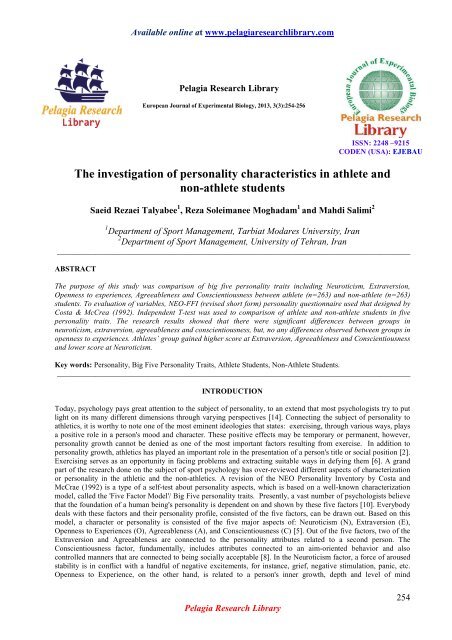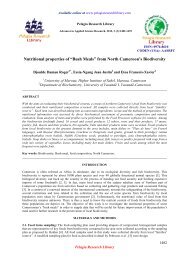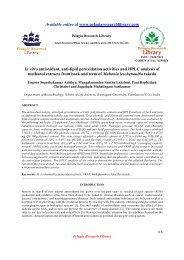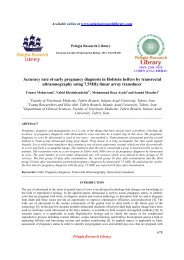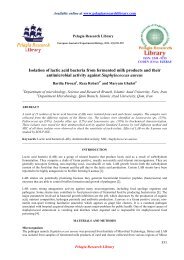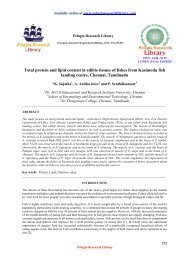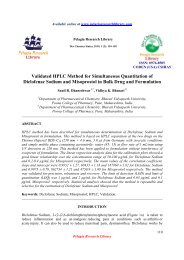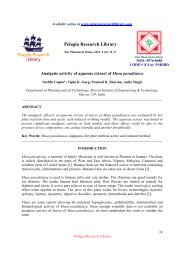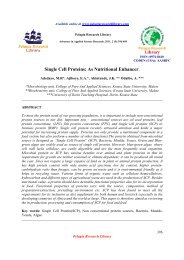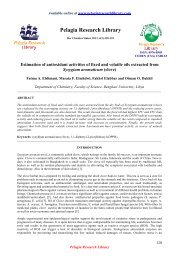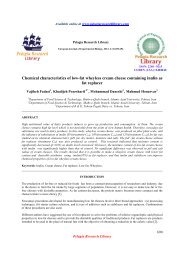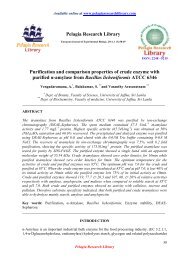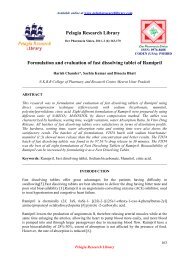The investigation of personality characteristics in athlete and non ...
The investigation of personality characteristics in athlete and non ...
The investigation of personality characteristics in athlete and non ...
Create successful ePaper yourself
Turn your PDF publications into a flip-book with our unique Google optimized e-Paper software.
Available onl<strong>in</strong>e at www.pelagiaresearchlibrary.com<br />
Pelagia Research Library<br />
European Journal <strong>of</strong> Experimental Biology, 2013, 3(3):254-256<br />
ISSN: 2248 –9215<br />
CODEN (USA): EJEBAU<br />
<strong>The</strong> <strong><strong>in</strong>vestigation</strong> <strong>of</strong> <strong>personality</strong> <strong>characteristics</strong> <strong>in</strong> <strong>athlete</strong> <strong>and</strong><br />
<strong>non</strong>-<strong>athlete</strong> students<br />
Saeid Rezaei Talyabee 1 , Reza Soleimanee Moghadam 1 <strong>and</strong> Mahdi Salimi 2<br />
1 Department <strong>of</strong> Sport Management, Tarbiat Modares University, Iran<br />
2 Department <strong>of</strong> Sport Management, University <strong>of</strong> Tehran, Iran<br />
_____________________________________________________________________________________________<br />
ABSTRACT<br />
<strong>The</strong> purpose <strong>of</strong> this study was comparison <strong>of</strong> big five <strong>personality</strong> traits <strong>in</strong>clud<strong>in</strong>g Neuroticism, Extraversion,<br />
Openness to experiences, Agreeableness <strong>and</strong> Conscientiousness between <strong>athlete</strong> (n=263) <strong>and</strong> <strong>non</strong>-<strong>athlete</strong> (n=263)<br />
students. To evaluation <strong>of</strong> variables, NEO-FFI (revised short form) <strong>personality</strong> questionnaire used that designed by<br />
Costa & McCrea (1992). Independent T-test was used to comparison <strong>of</strong> <strong>athlete</strong> <strong>and</strong> <strong>non</strong>-<strong>athlete</strong> students <strong>in</strong> five<br />
<strong>personality</strong> traits. <strong>The</strong> research results showed that there were significant differences between groups <strong>in</strong><br />
neuroticism, extraversion, agreeableness <strong>and</strong> conscientiousness, but, no any differences observed between groups <strong>in</strong><br />
openness to experiences. Athletes’ group ga<strong>in</strong>ed higher score at Extraversion, Agreeableness <strong>and</strong> Conscientiousness<br />
<strong>and</strong> lower score at Neuroticism.<br />
Key words: Personality, Big Five Personality Traits, Athlete Students, Non-Athlete Students.<br />
_____________________________________________________________________________________________<br />
INTRODUCTION<br />
Today, psychology pays great attention to the subject <strong>of</strong> <strong>personality</strong>, to an extend that most psychologists try to put<br />
light on its many different dimensions through vary<strong>in</strong>g perspectives [14]. Connect<strong>in</strong>g the subject <strong>of</strong> <strong>personality</strong> to<br />
athletics, it is worthy to note one <strong>of</strong> the most em<strong>in</strong>ent ideologies that states: exercis<strong>in</strong>g, through various ways, plays<br />
a positive role <strong>in</strong> a person's mood <strong>and</strong> character. <strong>The</strong>se positive effects may be temporary or permanent, however,<br />
<strong>personality</strong> growth cannot be denied as one <strong>of</strong> the most important factors result<strong>in</strong>g from exercise. In addition to<br />
<strong>personality</strong> growth, athletics has played an important role <strong>in</strong> the presentation <strong>of</strong> a person's title or social position [2].<br />
Exercis<strong>in</strong>g serves as an opportunity <strong>in</strong> fac<strong>in</strong>g problems <strong>and</strong> extract<strong>in</strong>g suitable ways <strong>in</strong> defy<strong>in</strong>g them [6]. A gr<strong>and</strong><br />
part <strong>of</strong> the research done on the subject <strong>of</strong> sport psychology has over-reviewed different aspects <strong>of</strong> characterization<br />
or <strong>personality</strong> <strong>in</strong> the athletic <strong>and</strong> the <strong>non</strong>-athletics. A revision <strong>of</strong> the NEO Personality Inventory by Costa <strong>and</strong><br />
McCrae (1992) is a type <strong>of</strong> a self-test about <strong>personality</strong> aspects, which is based on a well-known characterization<br />
model, called the 'Five Factor Model'/ Big Five <strong>personality</strong> traits. Presently, a vast number <strong>of</strong> psychologists believe<br />
that the foundation <strong>of</strong> a human be<strong>in</strong>g's <strong>personality</strong> is dependent on <strong>and</strong> shown by these five factors [10]. Everybody<br />
deals with these factors <strong>and</strong> their <strong>personality</strong> pr<strong>of</strong>ile, consisted <strong>of</strong> the five factors, can be drawn out. Based on this<br />
model, a character or <strong>personality</strong> is consisted <strong>of</strong> the five major aspects <strong>of</strong>: Neuroticism (N), Extraversion (E),<br />
Openness to Experiences (O), Agreeableness (A), <strong>and</strong> Conscientiousness (C) [5]. Out <strong>of</strong> the five factors, two <strong>of</strong> the<br />
Extraversion <strong>and</strong> Agreeableness are connected to the <strong>personality</strong> attributes related to a second person. <strong>The</strong><br />
Conscientiousness factor, fundamentally, <strong>in</strong>cludes attributes connected to an aim-oriented behavior <strong>and</strong> also<br />
controlled manners that are connected to be<strong>in</strong>g socially acceptable [8]. In the Neuroticism factor, a force <strong>of</strong> aroused<br />
stability is <strong>in</strong> conflict with a h<strong>and</strong>ful <strong>of</strong> negative excitements, for <strong>in</strong>stance, grief, negative stimulation, panic, etc.<br />
Openness to Experience, on the other h<strong>and</strong>, is related to a person's <strong>in</strong>ner growth, depth <strong>and</strong> level <strong>of</strong> m<strong>in</strong>d<br />
Pelagia Research Library<br />
254
Saeid Rezaei Talyabee et al Euro. J. Exp. Bio., 2013, 3(3):254-256<br />
_____________________________________________________________________________<br />
complication, as far as personal experience is concerned [12]. Us<strong>in</strong>g the Five Factor scale, Kajtna et al. (2004)<br />
compared the <strong>personality</strong> differences between <strong>athlete</strong>s do<strong>in</strong>g high-risk sports (Alp<strong>in</strong>e climb<strong>in</strong>g, ski<strong>in</strong>g, paraglid<strong>in</strong>g,<br />
white-water raft<strong>in</strong>g, mounta<strong>in</strong> bik<strong>in</strong>g, motorcycl<strong>in</strong>g, Ski jump<strong>in</strong>g, <strong>and</strong> speed ski<strong>in</strong>g) <strong>and</strong> <strong>athlete</strong>s do<strong>in</strong>g low risk<br />
sports [ swimm<strong>in</strong>g, athletics, Kayak sail<strong>in</strong>g, mounta<strong>in</strong>eer<strong>in</strong>g, Nordic walk<strong>in</strong>g, karate, canoe<strong>in</strong>g). <strong>The</strong>y arrived to the<br />
conclusion that <strong>in</strong> comparison to low risk sport <strong>athlete</strong>s, high-risk sport <strong>athlete</strong>s ga<strong>in</strong>ed better scores on emotional<br />
stability <strong>and</strong> lower po<strong>in</strong>ts on Conscientiousness <strong>and</strong> Openness to Experience. As far as the Agreeableness was<br />
concerned, there was no difference between the two groups. This survey had been done us<strong>in</strong>g the Five Factor Model,<br />
<strong>non</strong>etheless, it did not study the difference between <strong>athlete</strong>s <strong>and</strong> the <strong>non</strong>-<strong>athlete</strong>s [7]. In another survey, Filho et al.<br />
(2005) studied the difference <strong>in</strong> character between the <strong>non</strong>-<strong>athlete</strong>s <strong>and</strong> renowned Brazilian <strong>athlete</strong>s (<strong>in</strong> volleyball,<br />
basketball, judo <strong>and</strong> swimm<strong>in</strong>g) <strong>and</strong> noticed differences between the two groups regard<strong>in</strong>g eight <strong>personality</strong> traits.<br />
<strong>The</strong>se were: avoid<strong>in</strong>g to express<strong>in</strong>g one's feel<strong>in</strong>gs, mood<strong>in</strong>ess or quick sensitivity, rudeness or impoliteness,<br />
laz<strong>in</strong>ess, justness, health issue cares, frankness <strong>and</strong> excitement patterns. In this survey, a Twelve Factor Model had<br />
been used, where eight <strong>of</strong> the factors turned differ<strong>in</strong>g [6]. <strong>The</strong> aim <strong>of</strong> our survey, on the other h<strong>and</strong>, was to compare<br />
five <strong>personality</strong> elements <strong>in</strong> both groups <strong>of</strong> athletic students <strong>and</strong> <strong>non</strong>-athletic students <strong>in</strong> Tehran University, <strong>in</strong> order<br />
to answer the question whether there are <strong>personality</strong> differences between people who do sports <strong>and</strong> ones who do not,<br />
<strong>in</strong> general <strong>and</strong> if yes, to what degree.<br />
MATERIALS AND METHODS<br />
<strong>The</strong> present research is from the explanatory, reason-comparative type. Primary <strong>in</strong>formation has been collected by<br />
NEO-FFI <strong>personality</strong> questionnaire (the shortened <strong>and</strong> revised version <strong>of</strong> the Big Five Personality traits by Costa<br />
<strong>and</strong> Mccrae (1992).<br />
Research Sampl<strong>in</strong>g: <strong>The</strong> research board consists <strong>of</strong> all male students <strong>in</strong> Tehran University who had studied dur<strong>in</strong>g<br />
the first half <strong>of</strong> the 88-89 academic years. To <strong>in</strong>dicate the bulk <strong>of</strong> the sample, first, the male, athletic <strong>and</strong> the <strong>non</strong>athletic<br />
students were separated. <strong>The</strong>n, by the use <strong>of</strong> Cochran's bulk <strong>in</strong>dicat<strong>in</strong>g formula, the bulk <strong>of</strong> the athletic<br />
sample students, that <strong>of</strong> the 263 persons, was <strong>in</strong>dicated. Later the same number was used to sample <strong>non</strong>-athletic<br />
students. F<strong>in</strong>ally, after the bulk <strong>in</strong>dication, questionnaires were distributed among <strong>and</strong> later collected from the<br />
sample groups, accord<strong>in</strong>g to accidental sampl<strong>in</strong>g conditions.<br />
Variables <strong>in</strong> the Research: Independent variables <strong>in</strong> this research were that <strong>of</strong> the physical activity <strong>and</strong> exercise.<br />
<strong>The</strong> dependent variables were those <strong>of</strong> the five factors <strong>of</strong> <strong>personality</strong>: psychiatric affliction or Neuroticism,<br />
Extraversion, Agreeableness, Openness to Experiences <strong>and</strong> Conscientiousness.<br />
Analyz<strong>in</strong>g the data: After hav<strong>in</strong>g made sure that the distributed were those <strong>of</strong> the normal type, by Kolmogorov-<br />
Smirnov test; to f<strong>in</strong>d out the differences between the groups, the Independent T- test was used.<br />
RESULTS<br />
<strong>The</strong> highest average <strong>of</strong> the relevant <strong>personality</strong> factors <strong>in</strong> the athletics' group was scored for Extraversion with an<br />
average <strong>of</strong> 4.16 <strong>and</strong> the lowest for the Conscientiousness with an average <strong>of</strong> 3.00 (table 1).<br />
Table 1. Descriptive statics <strong>of</strong> Personal traits <strong>in</strong> athletic <strong>and</strong> <strong>non</strong>-athletic students<br />
athletic students <strong>non</strong>-athletic students<br />
Factor Mean S.d Mean S.d<br />
Neuroticism 3.30 1.30 3.93 1.17<br />
Extraversion 4.16 0.88 3.41 1.00<br />
Openness to Experiences 3.06 1.44 2.82 1.25<br />
Agreeableness 3.33 1.05 2.52 1.17<br />
Conscientiousness 3.00 1.29 2.19 1.03<br />
Table 2- T-test for Equality <strong>of</strong> Means<br />
Levene's Test for Equality <strong>of</strong> Variances T-test for Equality <strong>of</strong> Means<br />
F Sig. t df Sig. (2-tailed)<br />
Neuroticism 0.122 0.729 -3.35 524 0.001<br />
Extraversion 0.289 0.593 2.96 524 0.01<br />
Openness to Experiences 0.179 0.189 0.860 524 0.091<br />
Agreeableness 0.483 0.489 3.36 524 0.001<br />
Conscientiousness 0.073 0.788 2.56 524 0.022<br />
<strong>The</strong> highest average <strong>of</strong> the studied <strong>personality</strong> traits <strong>in</strong> the <strong>non</strong>-athletic group belonged to that <strong>of</strong> Neuroticism with<br />
an average <strong>of</strong> 3.93 <strong>and</strong> the lowest to Conscientiousness with an average <strong>of</strong> 2.19 (table 1). T-test results showed that<br />
there are mean<strong>in</strong>gful statistical differences between the athletic <strong>and</strong> <strong>non</strong>-athletic student groups regard<strong>in</strong>g the factors<br />
Pelagia Research Library<br />
255
Saeid Rezaei Talyabee et al Euro. J. Exp. Bio., 2013, 3(3):254-256<br />
_____________________________________________________________________________<br />
<strong>of</strong> Neuroticism, Extraversion, Agreeableness, <strong>and</strong> Conscientiousness. On the other h<strong>and</strong>, the groups did not show<br />
any significant differences for Openness to Experience. In conclusion, the variable averages show that the athletic<br />
students are on a higher st<strong>and</strong> regard<strong>in</strong>g the three traits <strong>of</strong> Extraversion, Agreeableness <strong>and</strong> Conscientiousness, <strong>in</strong><br />
comparison to the <strong>non</strong>-athletics. However, they rema<strong>in</strong> on a lower st<strong>and</strong> regard<strong>in</strong>g the Neuroticism trait.<br />
DISCUSSION AND CONCLUSION<br />
This research has been aimed towards the comparison <strong>of</strong> the Big Five <strong>personality</strong> traits, OCEAN, among the athletic<br />
<strong>and</strong> <strong>non</strong>-athletic male students <strong>in</strong> Tehran University. Results showed that there is significant difference between the<br />
two types <strong>of</strong> students when look<strong>in</strong>g at the Neuroticism <strong>and</strong> Extraversion traits. <strong>The</strong> research f<strong>in</strong>d<strong>in</strong>gs are parallel to<br />
results by Shokri et al. (2009), Mohammadi (2009), Burnik et al. (2005) <strong>and</strong> Phil Ive et al. (2005); however, <strong>in</strong><br />
contrast with Steere (2002), Naseri Tafti (2002) <strong>and</strong> Reiter et al. (2007) f<strong>in</strong>d<strong>in</strong>gs. <strong>The</strong> reason for such differences<br />
could be result<strong>in</strong>g from the different approaches <strong>and</strong> tools for collect<strong>in</strong>g <strong>in</strong>formation. In our research, an edited<br />
NEO-FFI form was used. In addition, when exam<strong>in</strong><strong>in</strong>g, a different society, differ<strong>in</strong>g sexual behavior should also be<br />
considered. Other f<strong>in</strong>d<strong>in</strong>gs <strong>in</strong> the present research are the lack <strong>of</strong> a considerable difference for the Agreeableness<br />
trait <strong>in</strong> between the two student groups. This certa<strong>in</strong> f<strong>in</strong>d<strong>in</strong>g from the research, from the content's perspective, is<br />
parallel to Naseri Tafti (2007), Burnik et al. (2005) <strong>and</strong> Reiter et al. (2007) f<strong>in</strong>d<strong>in</strong>gs; but aga<strong>in</strong> different from<br />
Steere's (2002). <strong>The</strong>re was considerable difference between the athletic <strong>and</strong> the <strong>non</strong>-athletic students for traits such<br />
as Agreeableness <strong>and</strong> Conscientiousness. This part <strong>of</strong> the f<strong>in</strong>d<strong>in</strong>gs is aga<strong>in</strong> parallel to results from Naseri Tafti<br />
(2004) <strong>and</strong> Besharat (2008) but, this time, there were no dissimilar results from other researcher. Most <strong>of</strong> the<br />
research done <strong>in</strong> this area show a higher score for Agreeableness <strong>and</strong> Conscientiousness <strong>in</strong> athletic rather than the<br />
<strong>non</strong>-athletics.<br />
In general, even though different researchers had used different methods to compare the athletic <strong>and</strong> the <strong>non</strong>-athletic<br />
people's <strong>personality</strong> traits, their f<strong>in</strong>d<strong>in</strong>gs have all been, more or less, the same. <strong>The</strong> observed differences <strong>in</strong><br />
researches done dur<strong>in</strong>g the many number <strong>of</strong> years could be a result <strong>of</strong> a few th<strong>in</strong>gs. One <strong>of</strong> the reasons, as already<br />
mentioned, could be that <strong>of</strong> us<strong>in</strong>g different tools. In addition, <strong>in</strong>terfer<strong>in</strong>g <strong>and</strong> chang<strong>in</strong>g variables (social position,<br />
economic situation, sexuality, age, etc.) <strong>in</strong> different societies should not be neglected. With regards to all said,<br />
researches show that, <strong>in</strong> general, people who do sports are much different <strong>in</strong> <strong>personality</strong> than those who don’t. <strong>The</strong>se<br />
differences do not necessarily show one group's superiority or preference to the other.<br />
REFERENCES<br />
[1] Besharat MA, Journal <strong>of</strong> Psychological Science, 2008, 23: 233-247.<br />
[2] Bett<strong>in</strong>a FP, Noemi K. Journal <strong>of</strong> Community Health, 2006, 31(2): 136-145.<br />
[3] Burnik S, Jug S, Kajtna T, Tusak M, Acta Univ, Palaka, Olomuc, Gymn, 2005, 35(2): 13-18.<br />
[4] Costa PT, McCrae RR, Revised NEO Personality Inventory (NEO-PI-R) <strong>and</strong> NEO Five-Factor Inventory (NEO-<br />
FFI) pr<strong>of</strong>essional manual, Psychological Assessment Resources, Odessa, FL, 1992<br />
[5] De Fruyt F, De Clercq BJ, van de Wiele L, Van Heer<strong>in</strong>gen K, Journal <strong>of</strong> Personality, 2006, 74(2), 479-510.<br />
[6] Filho MGB, Ribeiro LCS, García FG, Rev Bras Med Sport, 2005, 11(2): 114-118.<br />
[7] Kajtna T, Tušak M, Barić R, Burnik S, K<strong>in</strong>esiology, 2004, 36(1):24-34.<br />
[8] McGhee RM, Ehrler DJ, Buckhalt J, Five factor <strong>personality</strong> <strong>in</strong>ventory - children (FFPI-C)" Aust<strong>in</strong>, TX: Pro-Ed,<br />
2007.<br />
[9] Mohammadi Z, MA <strong>The</strong>sis, Faculty <strong>of</strong> Education <strong>and</strong> Psychology, University <strong>of</strong> Isfahan, 2009.<br />
[10] Naseri Tafti, MA <strong>The</strong>sis, Faculty <strong>of</strong> Education <strong>and</strong> Psychology, Shahid Beheshti University, Tehran, 2007.<br />
[11] Reiter MD, Liput T, Nirmal R, College Student Journal, 2007, http://www.f<strong>in</strong>darticles.com/.<br />
[12] Saulsman LM, Page AC, Cl<strong>in</strong>ical Psychology Review, 2004, 23: 1055-1085.<br />
[13] Shokri, Daneshvarpour, Asgari, Journal <strong>of</strong> Behavioral Science, 2009, 2: 127-142.<br />
[14] Skelton L, Dennis MA, Perceptual <strong>and</strong> Motor Skills, 1991, 72: 175-182.<br />
Pelagia Research Library<br />
256


